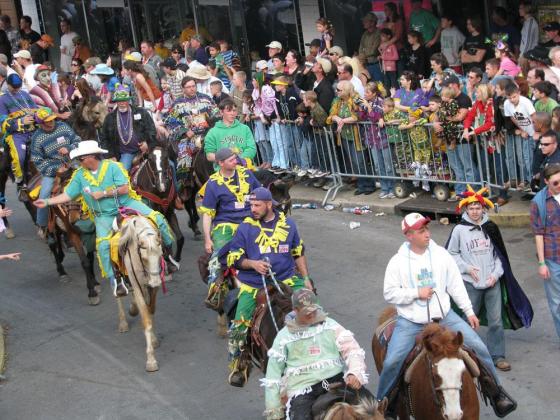
Jim Bradshaw
Courirs de Mardi Gras, rowdy horseback runs through south Louisiana’s countryside, now rival urban parades and pageants as local celebrations and attractions for visitors. They have deep roots in many smaller communities, but they were nearly done in by World War II.
Nobody’s sure of exactly where and when the first Mardi Gras riders played the fool and begged for chickens in south Louisiana. There is some evidence of rural runs by the middle 1800s, and researchers such as anthropologist Rocky Sexton say that both the urban and rural celebrations were well established in south Louisiana by 1900.
Sexton also notes that the rural courir and urban carnival come from different traditions. He says the early romps through south Louisiana had “striking” similarities to old mid-winter begging quests in Europe, in which costumed men made fun of the ruling classes and demanded food and money.
Those early celebrations, he says, were “characterized by outrageous behavior that [disrupted] notions of proper … behavior.” The participants wore colorful costumes and grotesque screen masks topped off with tall, peaked capuchons that spoofed hats worn by noblewomen in the Middle Ages. Some wore mortar boards like those we wore at graduation, or pointed bishop’s miters to make fun of scholars and the clergy. (See: Rocky Sexton, From France to Tee Mamou, Seven Hundred Years of Continuity and Change in a Traditional Begging Quest, 1990.)
Some of the south Louisiana courirs could be pretty rough in the early days. The masks and costumes provided cover for folks who wanted to settle old grudges with their fists or their horse whips, or, sometimes, knives and pistols.
“Additionally,” according to UL folklorist Barry Ancelet, “groups of riders, overwhelmed by the festive spirit, mildly terrorized a visited household … vandalizing the property, and stealing from the house (usually [from] the kitchen).” (See: “A Brief Overview of the Louisiana Cajun Country Mardi Gras.”)
Many small towns in south Louisiana were home to the Mardi Gras runs by the 1900s, and each of them had slightly different traditions. But the courirs began to die away until running the Mardi Gras had all but disappeared by the 1940s, when World War II sent many of the young participants far from home and festivities of any kind.
Community activists such as Paul Tate and Revon Reed worked to revive the tradition in Mamou after the war. Six Eunice men led capitaine Tobert Frugé reassembled in 1946, and during the 1950s, krewes of masked women also began to roam the countryside from communities such as Pointe Noire, Eunice, Duralde, Basile and Tee Mamou.
Even so, the courirs were pretty much local affairs until the 1960s, when the rest of the nation began to take notice of our cuisine and music and just how much fun we tend to have in Acadiana. Growing numbers of visitors began to find their way into the countryside to watch the rides, and even to participate in them in more recent years. The courirs now rival urban parades in popularity, and are flourishing.
For example, the Eunice Courir de Mardi Gras alone now has more than 2,000 participants. Courirs in other communities have shown similar growth, and it looks like that trend will continue.
A recent study on so-called “heritage tourism,” found “a steady rise in country Mardi Gras tourism over the last two decades” and predicted a lively future for them as more locals work to keep the tradition alive and more visitors come to watch them do it.
A collection of Jim Bradshaw’s columns, Cajuns and Other Characters, is now available from Pelican Publishing. You can contact him at jimbradshaw4321@gmail.com or P.O. Box 1121, Washington LA 70589.
